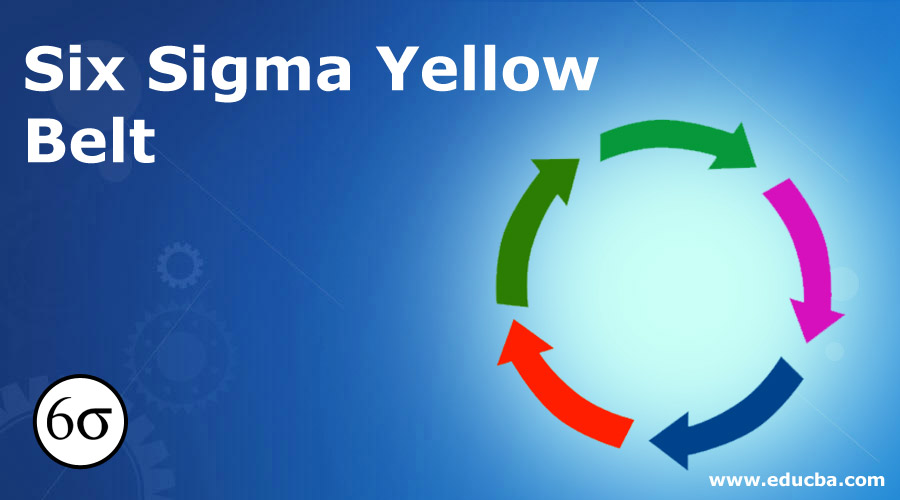
Introduction to Six Sigma Yellow Belt
The following article provides an outline for Six Sigma Yellow Belt. Six Sigma is a technique to eliminate the unwanted process to enhance the quality of the business. Six Sigma is a disciplined and data-driven technique to eradicate the defects and flaws from the process to which it is implemented, controlling the overall cost of the process and enhancing the quality and customer satisfaction. It is a measurement-based methodology that focuses on improvement and variation reduction by eliminating or removing the waste or defects from the process to which it is implemented. Six Sigma is fundamentally an enhanced version of lean methodology; thus, at some places, it is also known as the lean six sigma methodology.
It is a step to step process having its own hierarchy, which is represented below:

Different Belts in Six Sigma
Six Sigma is a professional certification for those who want to explore the area of quality and process improvement. The hierarchy of the six sigma certification is diagrammatically represented above, and the details for the different belts in the six sigma are given below:
- Champion: These are the people who consider quality above everything else in a process. Champions are the mentors, trainers, and coach of Black Belts and others in the organization.
- Master Black Belt: The Master Black Belts or the MBB are backed up by the champions in an organization. They are usually senior management employees in the organization.
- Black Belts: The Black Belts are backed up by the Master Black Belts and the champions. Black belt professionals are the ones who run a six sigma project under the guidance of the champion and the MBB.
- Green Belt: The Six Sigma Green Belt professionals are the ones who are involved with a six sigma project on a part-time basis. They work as a team member under the supervision of the six sigma team leader.
- Yellow Belt: Yellow belt certified candidates are the entry-level professionals of Six Sigma who have basic knowledge of the Six Sigma concepts and methodology. They are the ones who help the green belt certified professionals within an organization.
This certification is for the aspirants who wish to make a career in the quality sector. There are no eligibility criteria for taking up yellow belt certification. The yellow belt certified professionals are the team member assisting the Green Belt practitioners within an organization to enhance the process quality. The Six Sigma yellow belt certified professionals have basic knowledge and understanding of the Six Sigma concepts like the DMAIC and the quality tools required for process improvement and quality enhancement within an organization.
Sub Methodologies of Six Sigma
There are two sub methodologies under six sigma: DMAIC and DMADV.
As an entry-level representative of quality management, a six sigma yellow belt certified professional needs to be well versed with these two sub methodologies:
- DMAIC: DMAIC stands for Define, Measure, Analyze, Improve, and Control. DMAIC is the incremental improvement technique for an existing system falling below the specified quality standards.
- DMADV: DMADV stands for Define, Measure, Analyze, Design, and Verify. DMADV is the improvement technique that is used to enhance and maintain the quality standards of a newly developed process and products.
As mentioned above, there are no fixed eligibility criteria for six sigma yellow belt certification. Candidates who wish to make a career in quality management and want to gain foundational knowledge of the six sigma practices can go for the yellow belt certification. The aspirants of the Yellow Belt need to follow the LPAC rule for the Yellow Belt certification, which stands for Learn, Prepare, Apply and Certify.

A Six Sigma Yellow Belt certified professional is entitled to perform the following duties:
- A Yellow Belt has a foundational knowledge of Six Sigma concepts and practices.
- The yellow belt professionals work under the guidelines of the Green Belts and the Black Belts within an organization. They do not lead projects on their own, as does a Green Belt or Black Belt.
- Yellow Belt practices as either a core team member or a subject matter expert (SME) on DMAIC and DMADV project or process. They assist Green Belt or Black Belt professionals in developing process flow, helping with data analysis, facilitating a simulation, and process improvements.
- Yellow Belts may often be responsible for driving smaller process improvement projects using Lean tools or best practice sharing in their processes.
- For any project, Yellow Belts are those individuals who are the Experts or the Subject Matter Experts (SME’s) of respective processes and also have the basic acquaintance of Six Sigma. They are the foundation of the process and can help to uplift any Six Sigma process to closure by using their process expertise. For self-career, six sigma certified yellow belt professionals get exposure to channelizing their Subject information to process improvement opportunities yielding incredible benefits for self-understanding.
Yellow Belts have a broad knowledge of Six Sigma practices and concepts, which makes them eligible for a number of job positions such as that of Operations Manager, Process Engineer, Quality Engineer, Quality Analyst, Business Process Analyst, and Supply Chain Manager. The average salary of Lean Six Sigma Yellow Belt ranges from $67,000 to $99,000 per year, which obviously varies as per the knowledge and experience of the candidate. Also, the job profile of a yellow belt certified professional is a deciding factor for the salary. The yellow belt certification in six sigma offers a grand entry and a promising career in the quality management sector. The six sigma yellow belts are the pedestal members without whom the Green Belts or the Black Belts would not be able to implement the six sigma methodology to a process. The certification does not only help in improving business processes and increasing efficiency, but it also teaches the aspirant how to identify all kinds of waste or the unwanted in business — like defects, wasted talent, inventory issues, and overproduction. Anyone with a Six Sigma certification can identify these pinch points to the hilt and also deal with them in the most efficient and result-oriented manner.
Recommended Articles
This has been a guide to Six Sigma Yellow Belt. Here we have discussed the basic concept, different belts and sub methodologies in Six Sigma. You can also look at the following articles to learn more –

